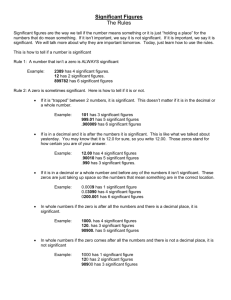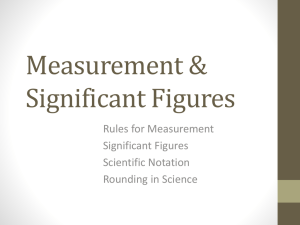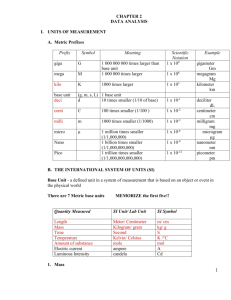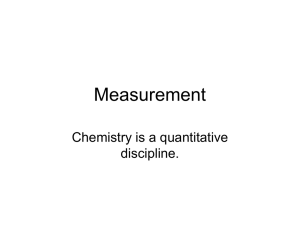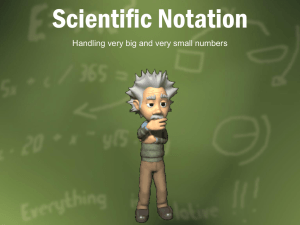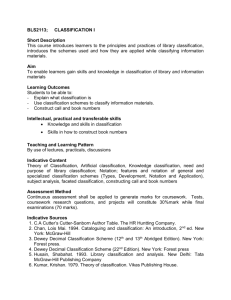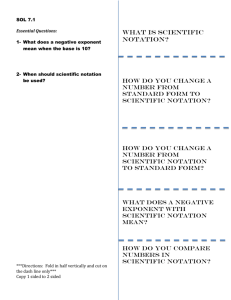Significant figures - Piscataway High School
advertisement
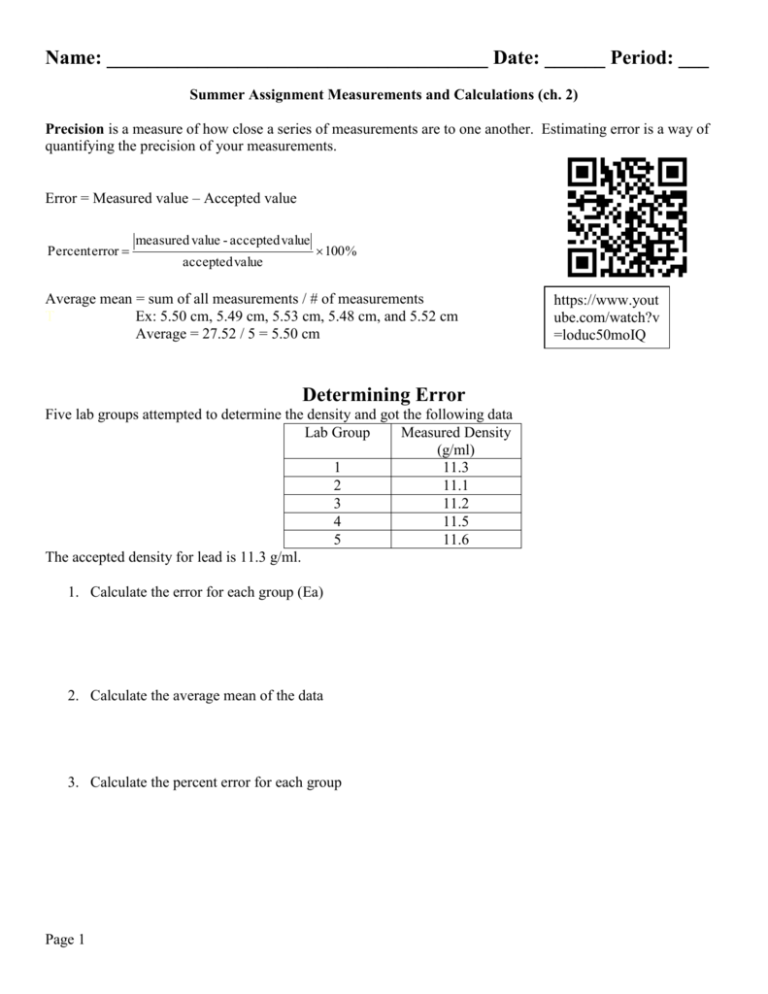
Name: ______________________________________ Date: ______ Period: ___ Summer Assignment Measurements and Calculations (ch. 2) Precision is a measure of how close a series of measurements are to one another. Estimating error is a way of quantifying the precision of your measurements. Error = Measured value – Accepted value Percent error measured value - accepted value accepted value 100 % Average mean = sum of all measurements / # of measurements T Ex: 5.50 cm, 5.49 cm, 5.53 cm, 5.48 cm, and 5.52 cm Average = 27.52 / 5 = 5.50 cm Determining Error Five lab groups attempted to determine the density and got the following data Lab Group Measured Density (g/ml) 1 11.3 2 11.1 3 11.2 4 11.5 5 11.6 The accepted density for lead is 11.3 g/ml. 1. Calculate the error for each group (Ea) 2. Calculate the average mean of the data 3. Calculate the percent error for each group Page 1 https://www.yout ube.com/watch?v =loduc50moIQ Accuracy is a measure of how close a measurement comes to the actual or true value of whatever is measured. A measurement can only be as accurate and precise as the instrument that produced it. A scientist must be able to express the accuracy of a number, not just its numerical value. We can determine the accuracy of a number by the number of significant figures it contains. Significant figures The last digit of a measurement expression is uncertain. That is because the last digit is an estimation. Significant figures in a measurement expression comprise all digits that known with certainty, plus one digit that is uncertain. PLACEHOLDERS ARE NOT SIGNFICANT. Rules for determining the number of significant figures in a given value: 1. All non-zero digits are significant. https://www.you tube.com/watch? v=eCJ76hz7jPM PRACTICE: Determine the number of significant figures in each of the measurements below. 2. All zeros between two nonzero digits are significant. (aka: sandwich rule) 1. 43.8 L 2. 43.08L 3. 4567.98g 4. 5678.09807 g 5. 3,400,008 mL 3. Trailing zeros are significant only if there is a decimal point or a bar drawn over the zero PRACTICE: determine the number of significant figures in each of the measurements below: 1. 345,00 g 2. 345,000,000 mL _ 3. 345, 000 cm _ 4. 345, 000 L 5. 345.000 mg 4. Zeros in the beginning of a number whose only function is to place the decimal point are not significant. Ex: 0.0025 has 2 significant figures. 5. Zeros following a decimal significant figure are significant Ex: 0.00470 has 3 significant figures PRACTICE: determine the number of significant figures in each of the measurements below: 1. 0.00876 mL 2. 20.0005 kg 3. 0.0008076 g 4. 0.080906L Page 2 5. 0.080006g 6. 987.00cm Significant figures - Determine the number of significant figures in the following measurements 1. 876 mL 6. 98.08 g 2. 00.345 L 7. 907,008 mL 3. 0.09045 g 8. 40.000 L 4. 987,000 cm 9. 40,000 g 5. 900,000 mL 10. 2.000 x 102 _ Calculating using significant figures Rule for Multiplying and Dividing Limit and round to the least number of significant figures of any of the factors. Example: 23.0 cm x 432 cm x 19 cm = 188,784 cm3 = 190,000 cm3 since 19 cm has only two significant figures Rule for Adding and Subtracting Limit and round your answer to the least number of decimal places Example: 123.25 mL + 46.0 mL + 86.257 mL = 255.507 mL = 255.5 mL since 46.0 mL has only one decimal place https://www.you tube.com/watch ?v=iorZdz4dsB U Perform the following operations expressing the answer in the correct number of significant figures. 1. 1.35 m x 2.467 m = ________________________ 2. 1,035 m2 / 42 m = ________________________ 3. 12.01 mL + 35.2 mL + 6 mL = ________________________ 4. 55.46 g – 28.9 g = ________________________ 5. 0.021 cm x 3.2 cm x 100.1 cm = ________________________ Page 3 https://www.yout ube.com/watch?v =xHgPtFUbAeU Scientific Notation Scientist very often deal with very small and very large numbers, which can lead to confusion when counting zeros. We have learned to express these numbers as powers. Scientific notation takes the form of M x 10n where 1 ≤ M < 10 and n represents the number of decimal places to be moved. Positive n indicates the standard form is a large number. Negative n indicates a number between zero and one. Example: Convert 1,400,000 to scientific notation. We move the decimal point so that there is only one digit to its left, a total of 6 places. 1.4 x 106 Example: Convert 0.000025 to scientific notation. For this we move the decimal place 5 places to the right. 0.000025 = 2.5 x 10-5 Convert the following to scientific notation: 1. 0.005 = ________________________ 2. 5,050 = ________________________ 3. 0.008 = ________________________ 4. 1,000 = ________________________ 5. 1,000,000 = ________________________ Convert the following to standard notation: 1. 1.5 x 103 = ________________________ 2. 1.5 x 10-3 = ________________________ 3. 3.785 x 10-2 = ________________________ 4. 3.75 x 102 = ________________________ 5. 2.2 x 105 = ________________________ Page 4 https://www. youtube.com /watch?v=i6l fVUp5RW8 Metric Conversions Length 10 mm = 1 cm 100 cm = 1 m 1000 mm = 1 m 1000 m = 1 km 1. 5 cm = _____ mm Facts You Need to Memorize Mass Volume 10 mg = 1 cg 10 mL = 1 cL 100 cg = 1 g 100 cL = 1 L 1000 mg = 1g 1000 mL = 1 L 1000 g = 1 kg 1000 L = 1 kL Examples: 10 mm 5cm 50mm 1 cm 2. 55 g = _______ mg 3. 500 mL = _______ L Volume of a solid 1 cm3 = 1mL 1000 mg 55,000 mg 1g 1L 500mL 0. 5L 1000mL 55g 4. 70 cm3 = _______ mL 70cm 3 1mL 70mL 1 cm 3 5. 0.01 kg = ________ g 0.01kg 1000 g 10 g 1 kg https://www.you tube.com/watch ?v=w0nqd_HX HPQ 1g 1kg 0.005897kg 1000 mg 1000 g Try these yourself and make sure to show your work like the above examples! 6. 5897 mg = _________ kg 5897mg 1. 500 g = ________kg 2. 25 cm = __________mm 3. 5 L = __________ mL 4. 15 km = _________ mm (Hint: this is a two step process) 5. 25000 mL = __________ kL (Hint: this is a two step process) Page 5 SI Unit Conversions Convert the following: (Make sure to show all work) Example: 4 km = __________ m 1. 3 m = __________ cm 2. 40 mL = __________ L 3. 52 g = __________ kg 4. 10 mm = __________ cm 5. 16 m = __________ km 6. 200 mg = __________ kg 7. 320 mm = __________ m 8. 3 km = __________ cm 9. 23 kg = __________ g 10. 17 L = __________ mL Page 6 4km 1000 m 4000m 1 km Temperature and its measurement Temperature (which means the average kinetic energy of the molecule) can be measured using three common scales: Celsius, Kelvin, and Fahrenheit. We use the following formulas to convert form one scale to another. Celsius is the scale most desirable for laboratory work. Kelvin represents the absolute scale. Fahrenheit is the old English scale, which is never used in lab. °C = K – 273 K = ° C + 273 Complete the following chart. All measurements are good to 1° C or better. °C 1 K 0° C 2 3 450 K 4 5 -273° C 6 294 K 7 8 9 Page 7 225 K -40 ° C Amount of weight lost Weight loss (lbs.) 30 25 20 15 10 5 0 0 1 2 3 4 5 6 Distance walked (km) The above picture is a line graph. Answer the following questions based on the above graph. 1. What is the independent or manipulated variable? 2. What is the dependent or response variable? 3. What are the units for distance? 4. What are the units for Weight loss? 5. Are both of these units part of the metric system? 6. Fill in the table below (Label each column and fill in the missing data from the above graph.) 1 10 3 20 5 7. What Formula should you use to find the slope of a line? 8. What is the slope of this curve (units are important)? Page 8 Determining Density through graphing A lab was completed in chemistry class. Students were asked to change the amount of water in a graduated cylinder for each trial. They had to mass the water and complete a graph. The data they obtained is listed in the table below. Create a plot of mass versus volume. Volume (mL) 5 15 24 52 64 Mass (g) 56.5 169.5 271.2 587.6 723.2 1. Calculate the slope of this graph. 2. What is the equation for density and how does it relate to the slope of this graph? 3. Using the data table below identify which substance was involved in this experiment? Substance Copper Lead Gold Page 9 Density (g/mL) 8.9 11.3 19.3 The Effect of Temperature on Reaction Rates Objective: What is the effect of temperature on the reaction rates of two chemicals? Materials: Two chemicals, thermometer, beakers, hot plate, and stopwatch Procedures: 1. Pour equal amounts of each chemical into a beaker. 2. Place the beaker onto a hot plate. 3. Set the temperature to 10 °C and time how long it takes the reaction to occur. 4. Repeat steps 1 – 3 with the following temperature: 15 °C, 25 °C, 30 °C, 40 °C, 45 °C, and 50 °C. Observations: Reaction Rates Data Temperature ( °C) 10 15 25 30 40 45 50 Reaction Time (seconds) 24 22 18 16 12 8 4 Your Task: Construct a graph of the following data Write a conclusion (Make sure you include the four parts of the conclusion) Make sure you answer the following when you write your conclusions. Conclusions must be written in the third person. 1. Answer the Objective 2. Explain the data and what was done during the lab 3. Make a prediction 4. Alka-Seltzer is used to help relieve upset stomachs or heartburn. Write one or two sentences explaining how you could make it work better. Page 10
